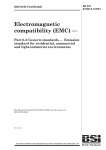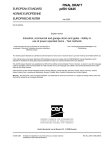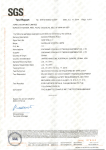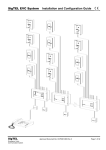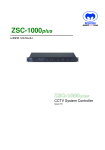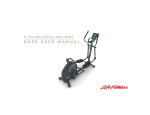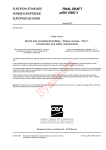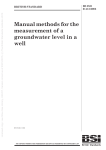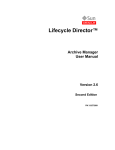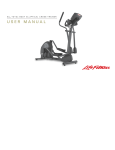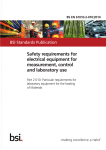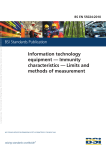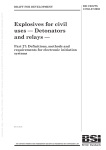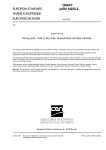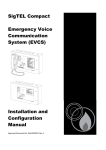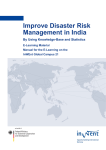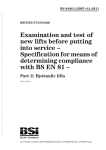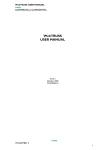Download EN 957-1
Transcript
Licensed Copy: London South Bank University, London South Bank University, Sun Mar 19 03:02:32 GMT 2006, Uncontrolled Copy, (c) BSI
BRITISH STANDARD
Stationary training
equipment —
Part 1: General safety requirements and
test methods
The European Standard EN 957-1:2005 has the status of a
British Standard
ICS 97.220.30
12&23<,1*:,7+287%6,3(50,66,21(;&(37$63(50,77('%<&23<5,*+7/$:
BS EN
957-1:2005
Licensed Copy: London South Bank University, London South Bank University, Sun Mar 19 03:02:32 GMT 2006, Uncontrolled Copy, (c) BSI
BS EN 957-1:2005
National foreword
This British Standard is the official English language version of
EN 957-1:2005. It supersedes BS EN 957-1:1997 which is withdrawn.
The UK participation in its preparation was entrusted by Technical Committee
SW/136, Sports, playground and other recreational equipment, to
Subcommittee SW/136/4, Stationary training equipment, which has the
responsibility to:
—
aid enquirers to understand the text;
—
present to the responsible international/European committee any
enquiries on the interpretation, or proposals for change, and keep
UK interests informed;
—
monitor related international and European developments and
promulgate them in the UK.
A list of organizations represented on this subcommittee can be obtained on
request to its secretary.
Cross-references
The British Standards which implement international or European
publications referred to in this document may be found in the BSI Catalogue
under the section entitled “International Standards Correspondence Index”, or
by using the “Search” facility of the BSI Electronic Catalogue or of British
Standards Online.
This publication does not purport to include all the necessary provisions of a
contract. Users are responsible for its correct application.
Compliance with a British Standard does not of itself confer immunity
from legal obligations.
Summary of pages
This document comprises a front cover, an inside front cover, the EN title page,
pages 2 to 17 and a back cover.
The BSI copyright notice displayed in this document indicates when the
document was last issued.
This British Standard was
published under the authority
of the Standards Policy and
Strategy Committee
on 13 January 2006
© BSI 13 January 2006
ISBN 0 580 46659 0
Amendments issued since publication
Amd. No.
Date
Comments
Licensed Copy: London South Bank University, London South Bank University, Sun Mar 19 03:02:32 GMT 2006, Uncontrolled Copy, (c) BSI
EUROPEAN STANDARD
EN 957-1
NORME EUROPÉENNE
EUROPÄISCHE NORM
August 2005
ICS 97.220.30
Supersedes EN 957-1:1996 + A1:1998
English Version
Stationary training equipment - Part 1: General safety
requirements and test methods
Appareils d'entraînement fixes - Partie 1 : Exigences
générales de sécurité et méthodes d'essai
Stationäre Trainingsgeräte - Teil 1: Allgemeine
sicherheitstechnische Anforderungen und Prüfverfahren
This European Standard was approved by CEN on 27 June 2005.
CEN members are bound to comply with the CEN/CENELEC Internal Regulations which stipulate the conditions for giving this European
Standard the status of a national standard without any alteration. Up-to-date lists and bibliographical references concerning such national
standards may be obtained on application to the Central Secretariat or to any CEN member.
This European Standard exists in three official versions (English, French, German). A version in any other language made by translation
under the responsibility of a CEN member into its own language and notified to the Central Secretariat has the same status as the official
versions.
CEN members are the national standards bodies of Austria, Belgium, Cyprus, Czech Republic, Denmark, Estonia, Finland, France,
Germany, Greece, Hungary, Iceland, Ireland, Italy, Latvia, Lithuania, Luxembourg, Malta, Netherlands, Norway, Poland, Portugal, Slovakia,
Slovenia, Spain, Sweden, Switzerland and United Kingdom.
EUROPEAN COMMITTEE FOR STANDARDIZATION
COMITÉ EUROPÉEN DE NORMALISATION
EUROPÄISCHES KOMITEE FÜR NORMUNG
Management Centre: rue de Stassart, 36
© 2005 CEN
All rights of exploitation in any form and by any means reserved
worldwide for CEN national Members.
B-1050 Brussels
Ref. No. EN 957-1:2005: E
Licensed Copy: London South Bank University, London South Bank University, Sun Mar 19 03:02:32 GMT 2006, Uncontrolled Copy, (c) BSI
EN 957-1:2005 (E)
Contents
page
Foreword ..........................................................................................................................................................3
Introduction......................................................................................................................................................4
1
Scope ...................................................................................................................................................5
2
Normative references .........................................................................................................................5
3
Terms and definitions.........................................................................................................................6
4
Classification.......................................................................................................................................7
5
Safety requirements............................................................................................................................8
6
Test methods.....................................................................................................................................12
7
Care and maintenance......................................................................................................................15
8
Assembly instructions......................................................................................................................15
9
General instructions for use ............................................................................................................15
10
Marking ..............................................................................................................................................16
Bibliography...................................................................................................................................................17
2
Licensed Copy: London South Bank University, London South Bank University, Sun Mar 19 03:02:32 GMT 2006, Uncontrolled Copy, (c) BSI
EN 957-1:2005 (E)
Foreword
This European Standard (EN 957-1:2005) has been prepared by Technical Committee CEN/TC 136 “Sports,
playground and other recreational equipment”, the secretariat of which is held by DIN.
This European Standard shall be given the status of a national standard, either by publication of an identical
text or by endorsement, at the latest by February 2006, and conflicting national standards shall be withdrawn
at the latest by February 2006.
This European Standard supersedes EN 957-1:1996 + A1:1998.
This standard EN 957 "Stationary training equipment" consists of the following parts:
— Part 1:
General safety requirements and test methods
— Part 2:
Strength training equipment, additional specific safety requirements and test methods
— Part 4:
Strength training benches, additional specific safety requirements and test methods
— Part 5:
Pedal crank training equipment, additional specific safety requirements and test methods
— Part 6:
Treadmills, additional specific safety requirements and test methods
— Part 7:
Rowing machines, additional specific safety requirements and test methods
— Part 8:
Steppers, stairclimbers and climbers - Additional specific safety requirements and test methods
— Part 9:
Elliptical trainers, additional specific safety requirements and test methods
— Part 10:
Exercise bicycles with a fixed wheel or without freewheel, additional specific safety requirements
and test methods
Part 3 has been amalgamated with part 2 after CEN Enquiry.
According to the CEN/CENELEC Internal Regulations, the national standards organizations of the following
countries are bound to implement this European Standard: Austria, Belgium, Cyprus, Czech Republic, Denmark, Estonia, Finland, France, Germany, Greece, Hungary, Iceland, Ireland, Italy, Latvia, Lithuania, Luxembourg, Malta, Netherlands, Norway, Poland, Portugal, Slovakia, Slovenia, Spain, Sweden, Switzerland and
United Kingdom.
3
Licensed Copy: London South Bank University, London South Bank University, Sun Mar 19 03:02:32 GMT 2006, Uncontrolled Copy, (c) BSI
EN 957-1:2005 (E)
Introduction
This part of EN 957 (hereinafter called the General Standard) specifies safety requirements that are generally
applicable to stationary training equipment. For specific types of equipment these requirements are supplemented or modified by the requirements of specific standards which have been issued as additional parts of
this European Standard.
Where specific standards exist, this general standard should not be used alone. Special care is required in
applying this general standard alone to equipment for which no specific standard has yet been published.
4
Licensed Copy: London South Bank University, London South Bank University, Sun Mar 19 03:02:32 GMT 2006, Uncontrolled Copy, (c) BSI
EN 957-1:2005 (E)
1
Scope
This European Standard specifies general safety requirements for stationary training equipment during use
unless modified in the other parts of this European Standard.
It also specifies a classification system (see Clause 4).
This European Standard is applicable to all stationary training equipment as defined in 3.1. This includes equipment for use in training areas of organizations such as sport associations, educational establishments, hotels,
sport halls, clubs, rehabilitation centres and studios (classes S and I) where access and control is specifically
regulated by the owner (person who has the legal responsibility), equipment for domestic use (class H) and other
types of equipment including motor driven equipment as defined in 3.1.
If a user has special needs (medical rehabilitation, disability) it is essential that the owner (the person with legal
responsibility) conducts a specific risk assessment to determine safe use and if necessary to insure trained staff
are available to supervise the activity.
The requirements of a specific standard take priority over the corresponding requirements of this general European Standard.
This European Standard does not apply to stationary training equipment intended for use by children.
NOTE 1
In the event that the stationary training equipment is intended for medical purposes, attention is drawn to the
requirements of Council Directive of 14 June 1993 on the approximation of the laws of the Member States relating to
medical devices 93/42/EEC in addition to the requirements of this European Standard.
NOTE 2
In the event that the stationary training equipment is designed to be accessible to people with disability, attention is drawn to any relevant national guidelines (see bibliography).
2
Normative references
The following referenced documents are indispensable for the application of this European Standard. For
dated references, only the edition cited applies. For undated references, the latest edition of the referenced
document (including any amendments) applies.
EN 60335-1, Household and similar electrical appliances — Safety — Part 1: General requirements
EN 60601-1, Medical electrical equipment — Part 1: General requirements for safety (IEC 60601-1:1988)
EN ISO 6508-1, Metallic materials — Rockwell hardness test — Part 1: Test method (scales A, B, C, D, E, F,
G, H, K, N, T) (ISO 6508-1:1999)
EN ISO 12100-1, Safety of machinery - Basic concepts, general principles for design - Part 1: Basic terminology, methodology (ISO 12100-1:2003)
ISO 8793, Steel wire ropes — Ferrule-secured eye terminations
5
Licensed Copy: London South Bank University, London South Bank University, Sun Mar 19 03:02:32 GMT 2006, Uncontrolled Copy, (c) BSI
EN 957-1:2005 (E)
3
Terms and definitions
For the purposes of this European Standard, the following terms and definitions apply.
3.1
stationary training equipment (hereinafter referred to as training equipment)
equipment that is not moved as a unit during use which either stands on the floor or is attached to a wall, ceiling or other fixed structure
NOTE
Training equipment can be used for example for the following:
a) physical culture, body building or body styling;
b) health fitness training;
c) physical education;
d) training specific to competition and related sports activities;
e) preventive treatment and rehabilitation.
3.2
training area
area in which the user and equipment can move when the equipment is used
NOTE
The training area can be utilized to deny third party access to dangerous parts of the equipment.
3.3
accessible hand and foot area (hereinafter referred to as accessible area)
area accessible to user or to third parties when the equipment is in normal use, during setting up, grasping,
adjusting the equipment or the position of the body for exercise
3.4
reverse force
yielding force (eccentric force) when e.g. lowering load
3.5
range of movement
space in which the user or part of the user is moving according to the instructions given in the user's manual
3.6
dynamic direction
direction in which the force is applied during a normal exercise as described in the user's manual
3.7
bodymass
this value is 100 kg or the maximum specified user weight as described in the user's manual whichever is
greater
3.8
intrinsic loading
loading due to user's bodymass
3.9
extrinsic loading
loads additional to the user's bodymass
6
Licensed Copy: London South Bank University, London South Bank University, Sun Mar 19 03:02:32 GMT 2006, Uncontrolled Copy, (c) BSI
EN 957-1:2005 (E)
3.10
maximum specified load
maximum load specified by the manufacturer
3.11
ergometer
any piece of training equipment that measures the input of power in Watts with a specific accuracy as defined
in the specific part of the standard
NOTE
This term can only be used for training equipment, which fulfills this condition.
3.12
speed dependent training equipment
training equipment where the braking torque cannot be adjusted and is proportional to the pedal speed, e.g.
fan driven bike
3.13
speed independent training equipment
training equipment where the braking torque can be adjusted by other means than speed
3.14
power driven training equipment
training equipment which is driven by external power (e.g. electric motors and pneumatic pistons)
4
Classification
4.1
General
Equipment shall be classified in accordance with accuracy and usage class as described in 4.2 to 4.4.
If the intended use of an equipment is for more classes it shall fulfill the requirements of each intended class.
4.2
Types
The type numbers used in the specific parts are taken from the part numbers.
EXAMPLE: Type 2: strength training equipment as defined in EN 957-2.
4.3
Accuracy classes
4.3.1
Class A: high accuracy.
4.3.2
Class B: medium accuracy.
4.3.3
Class C: minimum accuracy.
NOTE
Accuracy classes are shown in the additional specific parts of the standard.
7
Licensed Copy: London South Bank University, London South Bank University, Sun Mar 19 03:02:32 GMT 2006, Uncontrolled Copy, (c) BSI
EN 957-1:2005 (E)
4.4
Usage classes
4.4.1
Class S (Studio): professional and/or commercial use.
NOTE
Such training equipment is intended for use in training areas of organizations such as sport associations, educational establishments, hotels, clubs and studios, where access and control is specifically regulated by the owner (person
who has the legal responsibility).
4.4.2
Class H (Home): domestic use.
4.4.3 Class I: professional and/or commercial use provided for inclusive use for people with special needs
(e.g. visual, hearing, physical or learning disabilities).
Such equipment shall also be in compliance with class S requirements.
NOTE
Such training equipment is intended for use in training areas of organizations such as sport associations, educational establishments, hotels, clubs, rehabilitation centres and studios, where access and control is specifically regulated
by the owner (person who has the legal responsibility).
5
Safety requirements
NOTE
5.1
Concerning flammability there may be national regulations with which the products should comply.
Stability of free-standing equipment
When tested in accordance with 6.3, the training equipment shall not fall over.
5.2
5.2.1
External construction
Edges
All edges and corners of surfaces supporting bodies shall have a radius r > 2,5 mm.
All other edges of components which are accessible to the user or to third parties shall be free of burrs,
rounded or protected in some other way.
Test in accordance with 6.1.1 and 6.1.3.
5.2.2
Tube ends
When tested in accordance with 6.1.2, accessible tube ends shall be closed off either by parts of the equipment or by plugs.
The plugs shall remain in position at the end of the endurance load test, as prescribed in the relevant parts of
the applicable specific standard.
8
Licensed Copy: London South Bank University, London South Bank University, Sun Mar 19 03:02:32 GMT 2006, Uncontrolled Copy, (c) BSI
EN 957-1:2005 (E)
5.2.3
Squeeze, shear, rotating and reciprocating points within the accessible area
For accessible areas up to a height of 1 800 mm, when tested in accordance with 6.1.1 and 6.1.2, the distance
between movable parts and adjacent movable or rigid parts shall be not less than 60 mm except as follows:
a) if the fingers only are put at risk the distance shall be not less than 25 mm;
b) if the distance between moving part and rigid part does not change during movement the distance shall
be not more than 9,5 mm;
c) if appropriate stops and devices are necessary for safety reasons in the training area;
d) if uncontrolled access by third parties is prevented by the user's body position and where the user is able
to immediately stop the movement.
NOTE
This specification is designed to protect the hand and fingers from injury. Injury to other body parts is considered unlikely.
5.2.4
Weights
The range of motion of all weights attached to the training equipment shall be limited to that required to perform the exercise. Test in accordance with 6.1.2 and 6.1.4.
NOTE 1
This may be achieved by appropriate design.
NOTE 2
An example of an undesirable characteristic is an uncontrolled pendulum swing.
Stacked weights shall move freely and return to the resting point except when displaced intentionally.
5.3
Equipment access and escape
If the user cannot (after adjusting the equipment according to the manufacturer's instructions) attain the
loaded starting position for the equipment then the equipment shall be provided with an assist means, e.g.
pedal or lever to adjust the start/finish position of the exercise.
Testing in accordance with 6.7.
5.4
Adjustment and locking mechanisms
When tested in accordance with 6.1.2 and 6.1.4, adjustment facilities on the training equipment shall function
securely, be conspicuous and safely accessible to the user. The possibility of inadvertent alteration shall be
eliminated.
Adjustment components such as knobs and levers shall not interfere with the user's range of movement.
The proper function of any locking mechanism shall be clearly self-evident.
Weight selection pins shall be fitted with a retention device to prevent inadvertent alteration or movement during the exercise.
9
Licensed Copy: London South Bank University, London South Bank University, Sun Mar 19 03:02:32 GMT 2006, Uncontrolled Copy, (c) BSI
EN 957-1:2005 (E)
5.5
Ropes, belts and chains
5.5.1
General
Ropes, belts, chains and attachment devices shall have a safety factor against breakage of 6 times the maximum possible tension that can be developed. The diameter of the pulleys shall be in accordance with the applicable requirements of the rope, belt or chain manufacturers.
NOTE 1
Attachment devices are snap links, shackles, carabiners, clamps or similar (excludes e.g. handgrips).
When the tension developed is lower than the limit value specified in this European Standard, the equipment
shall be tested at that limit.
When tested in accordance with 6.4, the ropes shall not break and be capable of normal function.
NOTE 2
5.5.2
Normal function means no disconnection and no obvious damage.
Wire ropes and pulleys
5.5.2.1
Normal wire ropes shall be made of galvanized or corrosion-resistant wires. Test in accordance
with 6.1.5.
The rope nominal diameter (d) shall be related to the groove radius (r) of the pulley as follows:
the groove radius, r, shall lie within the range:
d
d
+ 5 % to + 15 %
2
2
with
d
+ 10 % as the optimum value.
2
Testing in accordance with 6.1.1.
Special wire ropes see 5.5.2.2.
5.5.2.2
The size and shape of the pulley shall be in accordance with the applicable requirements of the
rope, belt or chain manufacturers for the diameter and the groove. The specified endurance test of 100 000
cycles for class S and 12 000 cycles for class H as given in 6.8 shall be fulfilled.
5.5.2.3
Ferrules of wrought aluminium alloys shall be made in accordance with ISO 8793.
The rope ends shall be clamped flush with the clamping edge
( ) mm.
+2
0
On inspection the rope ends shall be clearly visible.
Pressed connections shall not be subjected to bending.
Wire rope grips shall only be used behind casings or similar protective devices.
Test in accordance with 6.1.2.
10
Licensed Copy: London South Bank University, London South Bank University, Sun Mar 19 03:02:32 GMT 2006, Uncontrolled Copy, (c) BSI
EN 957-1:2005 (E)
5.5.3
Rope and belt guides
The possibility of a rope or a belt becoming laterally disengaged or detached shall be prevented by rope or belt
guides.
Test in accordance with 6.1.2 and 6.1.4.
5.6
Pull in points
Pull in points of rope or belt drives up to 1 800 mm height shall be protected so that the user's hand, when extended, cannot be caught up.
NOTE
This can be achieved by ensuring that the angle between the rope and the guard is not less than 50°.
Rope and belt drives of a surface pressure ≤ 90 N/cm2 are excluded from this requirement.
Test in accordance with 6.1.6.
Pull in points for chains, gears and sprockets shall be protected in accordance with EN ISO 12100-1.
For flywheels the test finger (see Figure 1) shall not become trapped when tested in accordance with 6.5.
5.7
5.7.1
Gripping positions
Integral handgrips
Gripping positions shall be clearly marked and textured to prevent slipping. Test in accordance with 6.1.2.
5.7.2
Applied handgrips
When tested in accordance with 6.6, applied handgrips shall not be removed.
5.7.3
Rotating handgrips
Rotating handgrips shall be secured with a mechanical locking device and shall have textured surface to prevent
hand slipping.
Test in accordance with 6.1.2 and 6.1.4.
5.8
Electrical safety
Concerning electrical and electronic aspects of training equipment EN 60335-1 and for medical devices
EN 60601-1 shall be observed.
11
Licensed Copy: London South Bank University, London South Bank University, Sun Mar 19 03:02:32 GMT 2006, Uncontrolled Copy, (c) BSI
EN 957-1:2005 (E)
6
Test methods
6.1
General
6.1.1
Dimensional check
6.1.2
Visual examination
6.1.3
Tactile examination
6.1.4
Performance test
6.1.5
Manufacturer's certificate
6.1.6
Testing of pull in points
Apparatus: test finger in accordance with Figure 1.
Approach the pull in point with the test finger probe to determine whether the test finger can become trapped.
Introduce the test finger to the pull in point keeping the test finger parallel to the axis of the rotating part.
6.2
Test conditions
All testing shall be performed under the following conditions:
a)
temperature 23 °C ± 5 °C
b)
relative humidity of 55 % to 75 %
6.3
Stability test
Carry out the test with a secured test person of (100 ± 5) kg
at 10° in the dynamic direction and
at 5° in all other directions
while all exercises are carried out in the most onerous conditions of use (maximum range of movement and
maximum load).
6.4
Determination of breaking load of ropes, belts and chains
Measure the rope, belt or chain tension while applying the maximum specified load. Then perform a tensile test,
increasing the load linearly up to 6 times the tension measured previously.
6.5
Testing of flywheels
Insert the test finger (see Figure 1) from all sides into any possible entrapment point between the drive and
transmission elements, while the equipment is in normal operation.
Do not introduce the test finger beyond the edge of the protective covering.
Determine whether the test finger becomes trapped.
12
Licensed Copy: London South Bank University, London South Bank University, Sun Mar 19 03:02:32 GMT 2006, Uncontrolled Copy, (c) BSI
EN 957-1:2005 (E)
Dimensions in millimetres
Key
1 Handle
Ra-value ≤ 0,40 µm
Surface hardness ≥ HRC 40 (measured in accordance with EN ISO 6508-1)
Figure 1 — Test finger
6.6
Determination of the removing force of applied handgrips
Apply a force of 70 N carefully to the handgrip by means of an appropriate pulling device.
13
Licensed Copy: London South Bank University, London South Bank University, Sun Mar 19 03:02:32 GMT 2006, Uncontrolled Copy, (c) BSI
EN 957-1:2005 (E)
6.7
Testing of access/escape
6.7.1
Principles
A visual and performance test shall be carried out to determine whether or not an assisted means of
access/escape is required and to ensure that the machine functions properly according to the instructions in
the owners manual.
6.7.2
Procedure
Adjust the equipment for the test person's size according to the manufacturer's instructions. The test person
shall enter the equipment and attempt to get into the exercise start position as described in the operation instructions provided by the manufacturer. The test person shall be able to get into and back out of the starting
position with relative ease. If the lifting or assistance mechanism cannot be reached by the test person or if
the test person cannot get into the starting position easily then further adjustment of the equipment may be
required. If this is not the case (the equipment is properly adjusted to the operation instructions for the given
body size of the test person), then an assist means that moves the lifting or assistance mechanism into the
direction of lifting stroke shall be provided.
If an assist means is provided, then operate the mechanism and insure that it performs as described in the
operation instructions. Upon completion of the exercise and return of the lifting or assistance mechanism to
the rest position, actuation of the assist means shall stop the lifting or assistance mechanism prior to reaching
the unloaded rest position thereby allowing the user to exit from the loaded use position.
6.8
Testing of endurance load
Carry out the test as close as possible to normal exercise frequency and free of shocks for:
a)
class H
b)
class S 100 000 cycles over 80 % of the possible range of movement;
6.9
12 000 cycles over 80 % of the possible range of movement;
1)
with maximum load;
2)
in direction of load in accordance with the exercise instructions fixed by a 50 percentile man;
3)
with a frequency of movement in accordance to a pretest of 3 persons with personal training load.
Test report
The test report shall include at least the following information:
a)
name and address of testing laboratory and location where the test was carried out when different from
the address of the test laboratory;
b)
unique identification of report (such as serial number) and of each page, and total number of pages of the
report;
c)
name and address of client;
d)
description and identification of the test item;
e)
date of receipt of test item and date(s) of performance of test;
f)
identification of the test specification or description of the method or procedure;
g)
description of sampling procedure, where relevant;
14
Licensed Copy: London South Bank University, London South Bank University, Sun Mar 19 03:02:32 GMT 2006, Uncontrolled Copy, (c) BSI
EN 957-1:2005 (E)
h)
any deviations, additions or exclusions from the test specification, and any other information relevant to a
specific test;
i)
measurements, examinations and derived results, supported by tables, graphs, sketches and photographs as appropriate, and any failures identified;
j)
statement on measurement uncertainty (where relevant);
k)
signature and title or an equivalent marking of person(s) accepting technical responsibility for the test report and date of issue;
l)
statement to the effect that the test results relate only to the items tested.
7
Care and maintenance
Care and, if applicable, maintenance advice shall be provided with each piece of equipment. The advice shall
include at least:
a)
warning notice to the effect that the safety level of the equipment can be maintained only if it is examined
regularly for damage and wear, e.g. ropes, pulleys, connection points;
b)
advice to replace defective components immediately and/or keep the equipment out of use until repair;
c)
special attention to components most susceptible to wear.
8
Assembly instructions
If the training equipment requires assembly, a manual shall be supplied (in the national language), giving clear
and accurate assembly instructions relating to the training equipment.
If the training equipment requires assembly, then a list of tools needed shall be provided.
If the training equipment requires assembly, then a comprehensive parts list shall be supplied, including identifying part numbers.
The manufacturer shall indicate the total weight and the total surface area (e.g. foot print) of machine and the
recommended minimum values (forces) the wall fixings have to withstand. When training equipment is fixed,
e.g. to a wall, full assembly instructions shall be provided.
9
General instructions for use
Each item of training equipment shall be accompanied by instructions for use for the owner, in the national
language including at least the following information:
a)
customer service address;
b)
indication of field of application;
c)
information on the correct use (normal use) of the equipment and its features with the emphasis on safety,
including guidelines on the free space required for safe operation and the importance of keeping unsupervised children away from the equipment;
d)
exercise instructions with advice with regard to correct biomechanical positioning of the user on the training equipment. A warning indicating that injuries to health may result from incorrect or excessive training.
Instructions shall be given in respect of every major exercise type for which the equipment is designed;
e)
texts concerning difficult or complicated manœuvres shall be accompanied by illustrations;
f)
design illustration;
15
Licensed Copy: London South Bank University, London South Bank University, Sun Mar 19 03:02:32 GMT 2006, Uncontrolled Copy, (c) BSI
EN 957-1:2005 (E)
g)
warning that any of the adjustment devices that could interfere with the user's movement should not be
left projecting;
h)
warning that the equipment shall be installed on a stable base and properly levelled;
i)
setting of the load and equipment further adjustments (e.g. seat adjustments);
j)
indication of the maximum user's body weight;
k)
indication of the maximum training weight, if applicable.
10 Marking
Training equipment shall be permanently marked with the following minimum information:
a)
name or trademark and full address of the manufacturer, supplier or importer;
b)
maximum user's body weight and the maximum training weight for the individual exercise stations (if applicable);
c)
usage classes S, H or I and accuracy classes A, B, C can be combined (e.g. SA) if both classes are
specified in that part of the standard;
d)
individual code number (which contains information about type and year of manufacture);
e)
pictogram instructing the user to read the information supplied by the manufacturer.
If applicable, warning notices in the national language shall be provided for permanent fixing to the training
equipment.
The compliance with this standard may be displayed by the manufacturer at his own responsibility by the additional indication of EN 957 in connection with the letter symbol of the designation class(es) (class S, H and I).
16
Licensed Copy: London South Bank University, London South Bank University, Sun Mar 19 03:02:32 GMT 2006, Uncontrolled Copy, (c) BSI
EN 957-1:2005 (E)
Bibliography
IFI/UK 1 04 04, EFDS Inclusive Fitness Initiative — Interim Standards for the accreditation of IFI Fitness
equipment by equipment item; www.inclusivefitness.org
EN 957-2, Stationary training equipment - Part 2: Strength training equipment, additional specific safety requirements and test methods
17
Licensed Copy: London South Bank University, London South Bank University, Sun Mar 19 03:02:32 GMT 2006, Uncontrolled Copy, (c) BSI
BS EN
957-1:2005
BSI — British Standards Institution
BSI is the independent national body responsible for preparing
British Standards. It presents the UK view on standards in Europe and at the
international level. It is incorporated by Royal Charter.
Revisions
British Standards are updated by amendment or revision. Users of
British Standards should make sure that they possess the latest amendments or
editions.
It is the constant aim of BSI to improve the quality of our products and services.
We would be grateful if anyone finding an inaccuracy or ambiguity while using
this British Standard would inform the Secretary of the technical committee
responsible, the identity of which can be found on the inside front cover.
Tel: +44 (0)20 8996 9000. Fax: +44 (0)20 8996 7400.
BSI offers members an individual updating service called PLUS which ensures
that subscribers automatically receive the latest editions of standards.
Buying standards
Orders for all BSI, international and foreign standards publications should be
addressed to Customer Services. Tel: +44 (0)20 8996 9001.
Fax: +44 (0)20 8996 7001. Email: [email protected]. Standards are also
available from the BSI website at http://www.bsi-global.com.
In response to orders for international standards, it is BSI policy to supply the
BSI implementation of those that have been published as British Standards,
unless otherwise requested.
Information on standards
BSI provides a wide range of information on national, European and
international standards through its Library and its Technical Help to Exporters
Service. Various BSI electronic information services are also available which give
details on all its products and services. Contact the Information Centre.
Tel: +44 (0)20 8996 7111. Fax: +44 (0)20 8996 7048. Email: [email protected].
Subscribing members of BSI are kept up to date with standards developments
and receive substantial discounts on the purchase price of standards. For details
of these and other benefits contact Membership Administration.
Tel: +44 (0)20 8996 7002. Fax: +44 (0)20 8996 7001.
Email: [email protected].
Information regarding online access to British Standards via British Standards
Online can be found at http://www.bsi-global.com/bsonline.
Further information about BSI is available on the BSI website at
http://www.bsi-global.com.
Copyright
Copyright subsists in all BSI publications. BSI also holds the copyright, in the
UK, of the publications of the international standardization bodies. Except as
permitted under the Copyright, Designs and Patents Act 1988 no extract may be
reproduced, stored in a retrieval system or transmitted in any form or by any
means – electronic, photocopying, recording or otherwise – without prior written
permission from BSI.
BSI
389 Chiswick High Road
London
W4 4AL
This does not preclude the free use, in the course of implementing the standard,
of necessary details such as symbols, and size, type or grade designations. If these
details are to be used for any other purpose than implementation then the prior
written permission of BSI must be obtained.
Details and advice can be obtained from the Copyright & Licensing Manager.
Tel: +44 (0)20 8996 7070. Fax: +44 (0)20 8996 7553.
Email: [email protected].




















